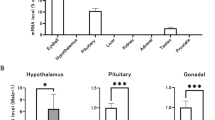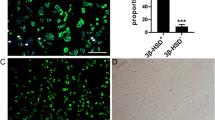Abstract
Androgen regulates the proper development and physiological function of the prostate. Here, we investigated the modulation of androgen and androgen receptor (AR) antagonist on circadian oscillations of a clock core gene Period 2 (Per2) in rat prostate mesenchymal cells (PMCs). Circadian oscillations were analyzed with the real-time monitoring system of gene expression using transgenic rats introduced with mouse Per2 promoter fused to a destabilized luciferase (Per2-dLuc) reporter gene. Analyses of circadian oscillations, immunofluorescence, and androgen response element (ARE)-luciferase reporter assay revealed that circadian clocks are operative and the AR protein is functional in PMCs in vitro. Androgen such as testosterone (T) and dihydrotestosterone (DHT) did not cause any changes in circadian Per2-dLuc oscillations of confluent cells. Conversely, flutamide (FL) up-regulated the amplitude of circadian Per2-dLuc oscillations in a dose-dependent manner, whereas T antagonized the action of FL. The PER2 protein was markedly accumulated by FL treatment and localized in both the nucleus and cytoplasm during the first peak period of circadian Per2-dLuc oscillations. Simultaneously, FL treatment increased apoptotic cell death. Collectively, the present study demonstrates that a clock gene Per2 is up-regulated in PMCs during FL-induced apoptotic cell death. Thus, circadian oscillations of Per2 gene expression may be closely linked to the cellular states of PMCs such as apoptotic cell death.








Similar content being viewed by others
References
Reppert SM, Weaver DR (2001) Molecular analysis of mammalian circadian rhythms. Annu Rev Physiol 63:647–676
Shearman LP, Sriram S, Weaver DR, Maywood ES, Chaves I, Zheng B, Kume K, Lee CC, van der Horst GT, Hastings MH, Reppert SM (2000) Interacting molecular loops in the mammalian circadian clock. Science 288:1013–1019
Ueda HR, Hayashi S, Chen W, Sano M, Machida M, Shigeyoshi Y, Iino M, Hashimoto S (2005) System-level identification of transcriptional circuits underlying mammalian circadian clocks. Nat Genet 37:187–192
Damiola F, Le Minh N, Preitner N, Kornmann B, Fleury-Olela F, Schibler U (2000) Restricted feeding uncouples circadian oscillators in peripheral tissues from the central pacemaker in the suprachiasmatic nucleus. Genes Dev 14:2950–2961
Schibler U, Sassone-Corsi P (2002) A web of circadian pacemakers. Cell 111:919–922
Yamamoto T, Nakahata Y, Soma H, Akashi M, Mamine T, Takumi T (2004) Transcriptional oscillation of canonical clock genes in mouse peripheral tissues. BMC Mol Biol 5:18
Lemos DR, Downs JL, Urbanski HF (2006) Twenty-four-hour rhythmic gene expression in the rhesus macaque adrenal gland. Mol Endocrinol 20:1164–1176
Nakamura TJ, Moriya T, Inoue S, Shimazoe T, Watanabe S, Ebihara S, Shinohara K (2005) Estrogen differentially regulates expression of Per1 and Per2 genes between central and peripheral clocks and between reproductive and nonreproductive tissues in female rats. J Neurosci Res 82:622–630
Dolatshad H, Campbell EA, O’Hara L, Maywood ES, Hastings MH, Johnson MH (2006) Developmental and reproductive performance in circadian mutant mice. Hum Reprod 21:68–79
He PJ, Hirata M, Yamauchi N, Hattori M-A (2007) Up-regulation of Per1 expression by estradiol and progesterone in the rat uterus. J Endocrinol 194:511–519
Hirata M, He PJ, Shibuya N, Uchikawa M, Yamauchi N, Hashimoto S, Hattori M-A (2009) Progesterone, but not estradiol, synchronizes circadian oscillator in the uterus endometrial stromal cells. Mol Cell Biochem 324:31–38
Morse D, Cermakian N, Brancorsini S, Parvinen M, Sassone-Corsi P (2003) No circadian rhythms in testis: Period1 expression is clock independent and developmentally regulated in the mouse. Mol Endocrinol 17:141–151
Alvarez JD, Chen D, Storer E, Sehgal A (2003) Non-cyclic and developmental stage-specific expression of circadian clock proteins during murine spermatogenesis. Biol Reprod 69:81–91
Alvarez JD, Sehgal A (2005) The thymus is similar to the testis in its pattern of circadian clock gene expression. J Biol Rhythms 20:111–121
He PJ, Hirata M, Yamauchi N, Hashimoto S, Hattori M-A (2007) The disruption of circadian clockwork in differentiating cells from rat reproductive tissues as identified by in vitro real-time monitoring system. J Endocrinol 193:413–420
He PJ, Hirata M, Yamauchi N, Hashimoto S, Hattori M-A (2007) Gonadotropic regulation of circadian clockwork in rat granulosa cells. Mol Cell Biochem 302:111–118
Akashi M, Ichise T, Mamine T, Takumi T (2006) Molecular mechanism of cell-autonomous circadian gene expression of Period2, a crucial regulator of the mammalian circadian clock. Mol Biol Cell 17:555–565
Balsalobre A, Brown SA, Marcacci L, Tronche F, Kellendonk C, Reichardt HM, Schutz G, Schibler U (2000) Resetting of circadian time in peripheral tissues by glucocorticoid signaling. Science 289:2344–2347
Balsalobre A, Marcacci L, Schibler U (2000) Multiple signaling pathways elicit circadian gene expression in cultured Rat-1 fibroblasts. Curr Biol 10:1291–1294
Tsuchiya Y, Minami I, Kadotani H, Nishida E (2005) Resetting of peripheral circadian clock by prostaglandin E2. EMBO Rep 6:256–261
Hinoi E, Ueshima T, Hojo H, Iemata M, Takarada T, Yoneda Y (2006) Up-regulation of per mRNA expression by parathyroid hormone through a protein kinase A-CREB-dependent mechanism in chondrocytes. J Biol Chem 281:23632–23642
Nakahata Y, Akashi M, Trcka D, Yasuda A, Takumi T (2006) The in vitro real-time oscillation monitoring system identifies potential entrainment factors for circadian clocks. BMC Mol Biol 7:5
Shirai H, Oishi K, Ishida N (2006) Circadian expression of clock genes is maintained in the liver of Vitamin A-deficient mice. Neurosci Lett 398:69–72
McKeehan WL, Adams PS, Fast D (1987) Different hormonal requirements for androgen-independent growth of normal and tumor epithelial cells from rat prostate. In Vitro Cell Dev Biol 23:147–152
Lu J, Danielsen M (1998) Differential regulation of androgen and glucocorticoid receptors by retinoblastoma protein. J Biol Chem 273:31528–31533
Catalona WJ (1994) Management of cancer of the prostate. New Engl J Med 331:996–1004
Xing RH, Rabbani SA (1999) Regulation of urokinase production by androgens in human prostate cancer cells: effect on tumor growth and metastases in vivo. Endocrinology 140:4056–4064
Chen ST, Choo KB, Hou MF, Yeh KT, Kuo SJ, Chang JG (2005) Deregulated expression of the PER1, PER2 and PER3 genes in breast cancers. Carcinogenesis 26:1241–1246
Hua H, Wang Y, Wan C, Liu Y, Zhu B, Yang C, Wang X, Wang Z, Cornelissen-Guillaume G, Halberg F (2006) Circadian gene mPer2 overexpression induces cancer cell apoptosis. Cancer Sci 97:589–596
Ueda HR, Chen W, Adachi A, Wakamatsu H, Hayashi S, Takasugi T, Nagano M, Nakahama K, Suzuki Y, Sugano S, Iino M, Shigeyoshi Y, Hashimoto S (2002) A transcription factor response element for gene expression during circadian night. Nature 418:534–539
Ravindranath N, Dym M (1999) Isolation of rat ventral prostate basal and luminal epithelial cells by the STAPUT technique. Prostate 41:173–180
Sato F, Kurokawa M, Yamauchi N, Hattori M-A (2006) Gene silencing of myostatin in chicken embryonic myoblasts by small interfering RNA. Am J Physiol 291:C538–C545
Han SJ, Tsai SY, Tsai MJ, O’Malley BW (2007) Distinct temporal and spatial activities of RU486 on progesterone receptor function in reproductive organs of ovariectomized mice. Endocrinology 148:2471–2486
Heinlein CA, Chang C (2004) Androgen receptor in prostate cancer. Endocr Rev 25:276–308
Pu Y, Huang L, Birch L, Prins GS (2007) Androgen regulation of prostate morphoregulatory gene expression: Fgf10-dependent and -independent pathways. Endocrinology 148:1697–1706
Darlington TK, Wager-Smith K, Ceriani MJ, Staknis D, Gekakis N, Steeves TDL, Weitz CJ, Takahashi JS, Kay SA (1998) Closing the circadian loop: CLOCK-induced transcription of its own inhibitors per and tim. Science 280:1599–1603
Travnickova-Bendova Z, Cermakian N, Reppert SM, Sassone-Corsi P (2002) Bimodal regulation of mPeriod promoters by CREB-dependent signaling and CLOCK/BMAL1 activity. Proc Natl Acad Sci USA 99:7728–7733
Pitkanen-Arsiola T, Tillman JE, Gu G, Yuan J, Roberts RL, Wantroba M, Coetzee GA, Cookson MS, Kasper S (2006) Androgen and anti-androgen treatment modulates androgen receptor activity and DJ-1 stability. Prostate 66:1177–1193
Yoon HG, Wong J (2006) The corepressors silencing mediator of retinoid and thyroid hormone receptor and nuclear receptor corepressor are involved in agonist- and antagonist-regulated transcription by androgen receptor. Mol Endocrinol 20:1048–1060
Montalvo L, Carmena MJ, Bolanos O, Rodriguez-Henche N, Sanchez-Chapado M, Prieto JC (2004) Effects of the antiandrogen flutamide on the expression of protein kinase C isoenzymes in LNCaP and PC3 human prostate cancer cells. Biosci Rep 24:11–21
Vindrieux D, Reveiller M, Florin A, Blanchard C, Ruffion A, Devonec M, Benahmed M, Grataroli R (2006) TNF-α-related apoptosis-inducing ligand decoy receptor DcR2 is targeted by androgen action in the rat ventral prostate. J Cell Physiol 206:709–717
Fu L, Pelicano H, Liu J, Huang P, Lee C (2002) The circadian gene Period2 plays an important role in tumor suppression and DNA damage response in vivo. Cell 111:41–50
Stevens RG, Rea MS (2001) Light in the built environment: potential role of circadian disruption in endocrine disruption and breast cancer. Cancer Causes Control 12:279–287
Zhu Y, Brown HN, Zhang Y, Stevens RG, Zheng T (2005) Period3 structural variation: a circadian biomarker associated with breast cancer in young women. Cancer Epidemiol Biomarkers Prev 14:268–270
Gery S, Virk RK, Chumakov K, Yu A, Koeffler HP (2007) The clock gene Per2 links the circadian system to the estrogen receptor. Oncogene 26:7916–7920
Acknowledgments
This research was supported in part by a Grant-in-Aid for Scientific Research (B) from Japan Society for the Promotion of Sciences (JSPS; no.17658131; to M-A H).
Author information
Authors and Affiliations
Corresponding author
Rights and permissions
About this article
Cite this article
Yoshida, K., He, Pj., Yamauchi, N. et al. Up-regulation of circadian clock gene Period 2 in the prostate mesenchymal cells during flutamide-induced apoptosis. Mol Cell Biochem 335, 37–45 (2010). https://doi.org/10.1007/s11010-009-0238-7
Received:
Accepted:
Published:
Issue Date:
DOI: https://doi.org/10.1007/s11010-009-0238-7




